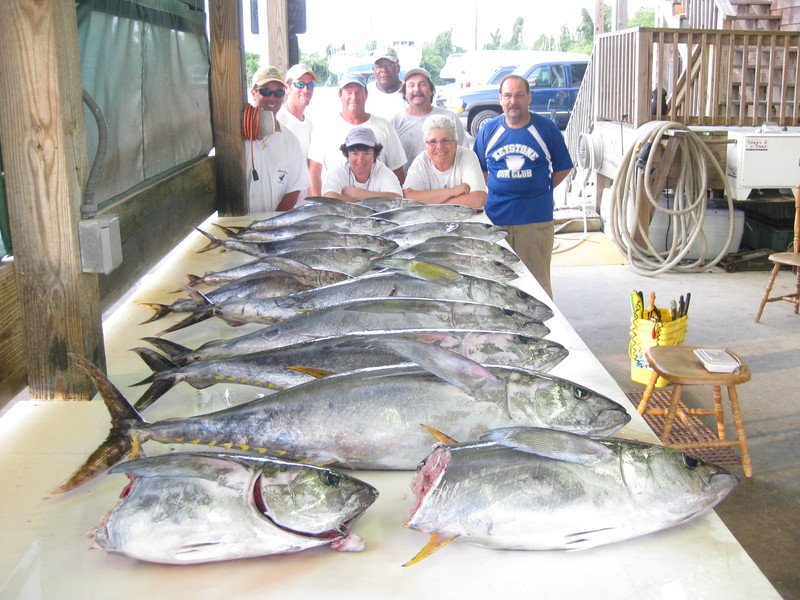Fishing improves with weather

Fishing has improved along with the weather, and anglers from Lewes, Indian River and Slaughter Beach are finding success.
Tuna remain the hot bite with yellowfins between the Wilmington and Baltimore canyons and bluefins over inshore lumps like the Hot Dog and Massey’s Canyon. Trolling with cedar plugs, Sea Witch and ballyhoo rigs and various other lures has been the ticket to success. In addition to the tuna, catches of dolphin, false albacore and billfish have been recorded. This is pretty early in the year for marlin, but several blues and whites have been released.
The mako shark bite remains good from the 20-Fathom Lumps on out to the deep. Shark expert Capt. Mark Sampson had one over 600 pounds fishing out of Ocean City, Md.
Inshore fishing has also improved with flounder making a strong showing at B Buoy, Site 10 and the Old Grounds. Capt. Brent Wiest on the Katydid managed a limit of 36 flounder one day last week. This is the largest number of flounder landed by one boat in a very long time. Individual anglers had decent numbers of keepers along with a few legal sea bass and ling in the same general area.
Indian River Inlet and Bay have been active. Flounder have been caught on a variety of baits with live spot accounting for the largest fish. Blues invade the inlet on incoming water along with some hickory shad.
Various reef sites in the Delaware Bay are beginning to produce flounder. Site 4 has been good for boats from Bowers Beach while 6 and 7 were visited by boats out of Slaughter Beach and Lewes. Site 8 hasn’t been mentioned in reports, but I suspect there are flounder out there.
Today is the opening of the summer rockfish season, and there should be plenty of slot fish between 20 and 26 inches available. Catch-and-release anglers have reported rock in the canal, the Broadkill River and at the Outer Wall. I plan to give it a try today and as often as possible during the season.
Croaker and spot are beginning to show up in the canal, the Broadkill River and Indian River, where small pieces of bloodworms, FishBites or Gulp! have attracted their attention. The Cape Henlopen Fishing Pier will soon have anglers lining the rail.
Big ocean - small boat
There is an old sailor’s prayer that goes something like, ”O Lord, thy ocean is so large and my boat is so small.” If you have a small boat in the 20- to 25-foot class and would like to fish farther out in the ocean you might want to keep that prayer in mind.
I first fished the Baltimore and Poorman’s canyons in 1973 aboard my brother-in-law Paul Coffin’s 22-foot Mako, “Little Boat.” He had the boat for a year before we made the 60-mile run, and during that time we equipped it with what we hoped would be the right stuff. That first year we ran as far out as the Lightship trolling for bluefish and bluefin tuna and had great success. We discovered that the outriggers that came with the boat were not up to the task. The same was true for the downrigger. Fuel was a major concern, and Paul installed a second tank in place of the cooler seat forward of the console.
With sturdy outriggers and the downrigger removed plus the additional fuel, we felt ready to make the long run. We ran from Barbara Porter’s South Shore Marina and usually had other boats that ran out with us.
In today’s boating world, things are much easier and safer for the small-boat offshore angler. The advances in marine electronics and GPS navigation are a far cry from the compass we had in 1974. Four-stroke outboards are much more reliable than the pair of two-stroke 75-HP Johnsons we ran.
Today I would not venture out of sight of land without an EPIRB (emergency position-indicating radio beacon). Cell phones don’t work out there, and the VHF radio is line of sight, so all you can contact is another boat. You must take every precaution to make your adventure as safe as possible. You must file a float plan with someone on shore who can call the Coast Guard if they don’t hear from you at the appointed time.
Going 60 to 70 miles out in a small boat is not for the faint of heart. Make sure the crew is up to the task. Being seasick a mile from the dock becomes an entirely different situation when you are three hours from shore.
Last but not least is the weather. The forecast must be perfect, and even then you can expect a bumpy ride home as the wind usually kicks up close to shore in the afternoon.




















































